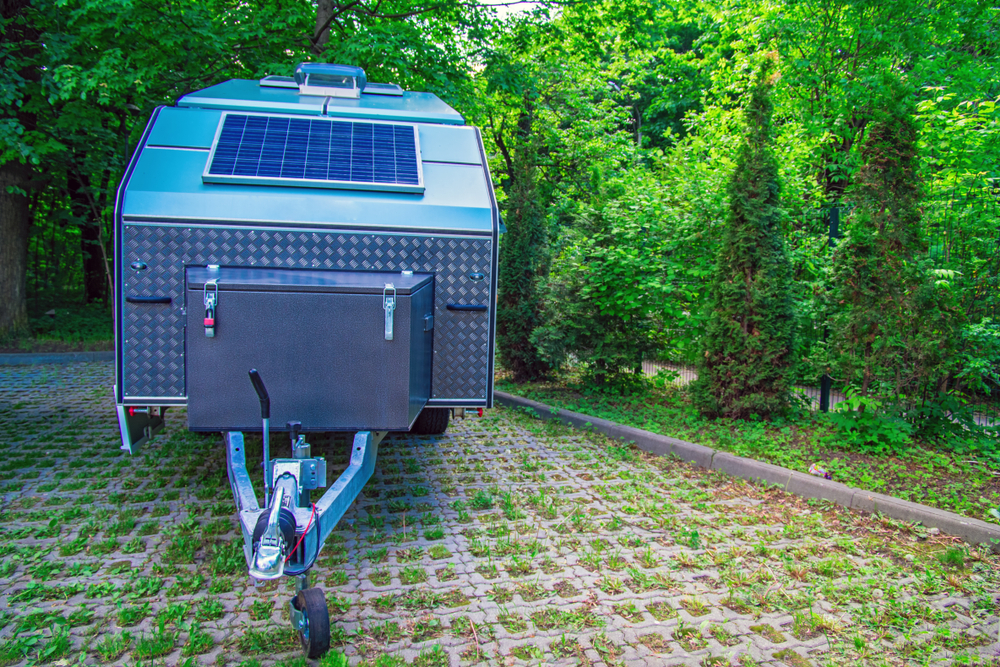RVs are a great way to see the world and enjoy the outdoors without leaving behind the creature comforts of home. You can pull off the highway and find a nice, quiet spot to stop and watch the sunset. Then, seconds after sundown, there’s an awful chugging. Suddenly your neighbor’s generator comes to life, and the whole park is drowned in a sea of exhaust fumes. “If only there was a better way!” you grumble as you claw your way back into the safety of your rig.
There is. Just like the solar panels you can buy for your house, you can have an incredible solar array on your RV. In this guide, we will arm you with all the information you need to buy your own RV solar kit, starting with a short guide. We’ll then give you the ten best kits along with our reviews. Finally, we’ll aim to provide you an in-depth guide and answer any questions you might still have at the bottom.
- Shining Light on Solar Kits
- Top 10 Best RV Solar Kits 2025
- 1. Best Overall RV Solar Kit: Renogy 200 Watt Solar Starter Kit
- 2. Best Premium Kit: WindyNation 400 Watt Solar Panel Kit
- 3. Best Starter System: WindyNation 100 Watt Solar Panel Kit
- 4. Best for Small RVs or Overlanders: Go Power! Weekender
- 5. Most Portable: ACOPOWER 100W Solar Panel Kit
- 6. Best Budget: HQST 100 Watt Solar Panel Kit
- 7. Best Space Saving: XINPUGUANG 100w Flexible Solar Panel
- 8. Best for High Energy Needs: ECO-WORTHY 1KW Solar Panel Kit
- 9. Best Simple Travel Kit: GVSHINE 30W Panel Foldable Solar Panel Kit
- 10. Best Kit With a Backup Source: ECO-WORTHY Wind and Solar Power Kit
- The Big Guide to RV Solar
- FAQ
- Enjoy Peaceful Power
Shining Light on Solar Kits
Adding solar to your RV can seem really complicated. In this quick guide, we will break down the different parts and take the mystery away so you can confidently buy the kit that suits your lifestyle.
Solar Basics
At the core, photovoltaic cells (PV), the fancy way to say solar panels, take sunlight, and convert it into DC voltage. That’s straightforward enough.
DC vs. AC
Your RV likely has a few systems that run on DC, or 12v, power. The engine does, and often the water pumps, cabin lights, and warning systems do as well. DC power from solar panels can basically do everything you can do using batteries instead of turning on your generator. The problems and complications with solar arise when you want to use that power to make some popcorn in a microwave. It’s not just a microwave, but anything that runs off a normal house, or 110v, outlet.
It takes a lot of solar power to make a microwave run, and the only way to get a lot of solar power is to have a lot of solar panel surface area. An RV simply does not have the space for big systems. Then, just to add extra problems to the mix, microwaves don’t run on DC power; they run on AC power. You can’t just plug in some solar panels into your electrical panel and get satisfactory results.
Batteries and Inverters
Fear not, brave citizens, there is a solution. Instead of trying to run the microwave off solar power, you can run it off batteries. Batteries can hold a lot of energy. With the help of a device called an inverter, they can easily power your microwave.
Solar panels are really good at charging batteries. Any household battery charger you plugin works by sending a small amount of DC voltage to a battery over a long time, exactly how a solar panel operates. That means a solar kit has to use the sun to charge batteries, and then you can use the batteries to power your appliances. It’s nice when everything works out.
The Major Parts of a Solar System
No, we aren’t talking about the planets; we are talking about everything you need to utilize solar power on your RV. We’ll get a lot more in-depth about each component down in the full guide.
For now, just know that a kit can contain some or all of these components. Any parts not contained in the kit are components you will have to source yourself if your RV doesn’t already have them.
- Panels: The panels can be either Monocrystalline or Polycrystalline panels are cheaper but make less power for the size.
- Wires: Wires, plugs, and connectors transport power from the PV array to other components.
- Charge Controller: A charge controller regulates the amount of power going into the batteries, so they don’t explode.
- Batteries: Batteries hold onto the power so you can use it at your convenience. Conventional lead-acid batteries, like the ones in your car, are not preferred for use in modern systems. Instead, AGM batteries or the more expensive, more efficient Lithium batteries are what you need.
- Inverter: The inverter converts DC power from the batteries into AC power for the outlets. We’ll discuss inverters in-depth later on. Be aware that many RVs have an inverter installed already.
- Extras: Kits can contain a variety of extras, like battery monitors, USB chargers for phones and lights, and fuse/breaker panels for convenient wiring.
How Much Solar Do You Need?
The short answer to the question is that you need enough wattage from solar as it takes to make sure your batteries are full after a full day of sunlight, and you need enough batteries to run all the appliances you want to run. An online calculator like this one can make it easy to calculate.
Unfortunately, there are still a lot of variables. How much sun you get, how many batteries you have room for and plan on buying, how much room you have for the solar panels, and perhaps most importantly, how much you can afford.
Rather than worry too much about getting the biggest, nicest solar kit on the market, our advice is to start small and expand over time. Adding solar panels or batteries is the easy part once the rest of the installation is done. Even if you get a system that isn’t quite what you need, you can always add more panels in the future.
With that short overview out of the way, let’s get into the reviews. It’s important to note that the best system for you may not be the one we think is the best. The best one for you is the one that fits your budget, power requirements, and space constraints. You will likely have to compromise on one of those categories, so we include a description of who each kit is best for in our reviews.
| Product | Wattage | PV Type | Batteries | Rating |
|---|---|---|---|---|
| Renogy 200 Watt Solar Starter Kit | 200 | Monocrystalline | Not Included | 5 |
| WindyNation 400 Watt Solar Panel Kit | 400 | Polycrystalline | 4 100ah AGM | 4.5 |
| WindyNation 100 Watt Solar Panel Kit | 100 | Polycrystalline | 1 100ah AGM | 4.5 |
| Go Power! Weekender | 190 | Monocrystalline | Not Included | 4 |
| ACOPOWER 100W Solar Panel Kit | 100 | Monocrystalline | Not Included | 4 |
| HQST 100 Watt Solar Panel Kit | 100 | Polycrystalline | Not Included | 4 |
| XINPUGUANG 100w Flexible Solar Panel | 200 | Monocrystalline | Not Included | 4 |
| ECO-WORTHY 1KW Solar Panel Kit | 1000 | Monocrystalline | 2 100ah AGM | 4 |
| GVSHINE 30W Panel Foldable Solar Panel Kit | 30 | Polycrystalline | 1 14ah Lithium | 4 |
| ECO-WORTHY Wind and Solar Power Kit | 100 (solar) 400 (wind) | Monocrystalline | Not Included | 3.5 |
Top 10 Best RV Solar Kits 2025
1. Best Overall RV Solar Kit: Renogy 200 Watt Solar Starter Kit
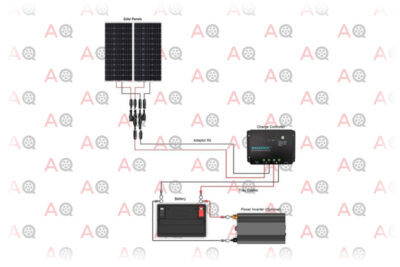
Editor’s Rating:
Facts
- Wattage: 200
- PV Type: Monocrystalline
- Batteries: Not Included
What’s in the Kit?
In the kit, you get mounting brackets, wires, and a charge controller. One of the things that set Renogy apart is their cabling. We know that doesn’t sound really exciting, but they have these super easy to install boxes that house all the connections and junctions. That makes the entire install one of the cleanest you can get.
You’ll have to source your own batteries, which is unfortunate. That’s standard, though; only a few kits are like the WindyNation kit on our list and actually include batteries in the package. The good news is that this Renogy kit comes standard with a lithium ready charge controller, so you won’t have to upgrade it if you decide to invest in high-end batteries.
Who’s It Best For?
This is the perfect kit for someone that wants to do things on a budget but doesn’t want to sacrifice quality. Especially if that person wants to upgrade items in the future. The panels are high efficiency and can stand up to a lot of abuse. They will last long enough that when you upgrade, you will be adding more panels, not replacing them.
200w with 2 batteries is a great amount for small to medium RVs and trailers, and it’s a perfect starting point for larger rigs. The lack of included batteries lends itself well to being a starter system, too. Your RV probably already has a small battery bank, so you can still upgrade to solar and then upgrade your batteries later.
Our Thoughts
This is easy. If you are on a budget and want to build a system over time and want to make sure that the system is high-quality when you are done, get this kit.
Just buy it with the knowledge that it’s not complete yet. It doesn’t come with fuses or blocks; you’ll have to buy those separately or use the existing ones on your RV. It doesn’t come with batteries and it doesn’t come with an inverter – it’s just some nice solar panels and a charger.
We have two kits on our list that are more complete: the WindyNation 400 watt and the ECO-WORTHY 1kw. They both have batteries and inverters. They are also more than four times the cost of this kit and require a lot more work.
Pros
- Easy to install
- Panels are high-quality
- The charge controller is one of the better ones available
Cons
- Doesn’t include batteries
- Doesn’t include some smaller components like fuses

Editor’s Rating:
Facts
- Wattage: 400
- PV Type: Polycrystalline
- Batteries: 4 100ah AGM
What’s in the Kit?
Everything. You get four AGM batteries with an inverter to maximize their use. You get four 100w solar panels and all the wiring to hook them up. You get a charge controller and mounting hardware.
You don’t get a battery meter, which is unfortunate. You also are only getting polycrystalline panels. We wish that WindyNation had chosen to go with monocrystalline panels like the Renogy kit uses. The price is already steep so it wouldn’t cost that much more, and you’d get another 50w or so from the same amount of space.
Who’s It Best For?
Do you have a larger trailer or RV, but you don’t want to spend time sourcing out any of your own parts? Then this kit is perfect since it has everything you need. Smaller rigs can get by with the WindyNation 100 Watt, but anything with a/c, a microwave, and a TV really needs 300-400 watts and 3 batteries. This kit has 400 watts and 4 batteries, so you are good to go.
Our Thoughts
It’s nice when you buy a DIY kit for a project, and it actually has all the parts you need to finish the project. That’s what this kit is. It’s just everything you need to install a 400w solar system onto your rig.
We have two big complaints. They aren’t really deal-breakers because they are easy to fix down the road with a few upgrades, but we would gladly accept a higher price if WindyNation had just included them in the kit. Like we mentioned before, the first is that we wish they had gone with higher-quality monocrystalline panels.
The second is that we wish they included a pure wave inverter like the one Go Power has. The modified wave inverter included in this kit isn’t terrible, but it’s not much more expensive to get something far less likely to hurt sensitive electronics.
Pros
- Includes batteries
- Generates enough power for larger RVs
- Includes an inverter
Cons
- Solar panels could be better quality
- The inverter could be better quality too
3. Best Starter System: WindyNation 100 Watt Solar Panel Kit

Editor’s Rating:
Facts
- Wattage: 100
- PV Type: Polycrystalline
- Batteries: 1 100ah AGM
What’s in the Kit?
This kit is ¼ of the big WindyNation kit. It has one 100 watt panel instead of four, it has one battery instead of four, and it has a few wires instead of a ton. It does use the same framework as the big system, though, so upgrading at a later point in time is easy. Adding panels and batteries is literally a plug and play process.
It doesn’t have an inverter, though. It also doesn’t come with fuses or junctions or anything; it’s just a charger, wires, a panel, and a battery. You may even want to source your own cables. The included wiring is 10 AWG, but 8 is recommended for 20ft runs.
Who’s It Best For?
The quality of the WindyNation panel and charger is a step below the quality of the Renogy system. The big difference is that WindyNation includes a single AGM battery for you. If you have a small travel trailer or Class C that doesn’t already have a battery bank, then that included battery is just what the doctor prescribed.
Our Thoughts
Unlike the WindyNation 400w we recommend, we don’t really have an issue with the fact that it’s a polycrystalline panel. We don’t have an issue with the slow charge controller, either. That’s because this system is a lot less expensive. You can tell they were trying to keep the price low, and campers on a budget will appreciate that.
That being said, we do feel like they could have included an inexpensive inverter. It’s really the only thing missing from the kit. You can easily run lights, pumps, and charge your cell phone, but you wouldn’t be able to use the electric coffee pot. You can buy one here that’s a pure sine inverter and rated to 500 watts, and doesn’t cost that much. It’d just be nice if it was in the kit ready to be hooked up.
Pros
- Inexpensive
- Comes with a battery
- It’s expandable
Cons
- Doesn’t include an inverter
- The quality of the components could be better
4. Best for Small RVs or Overlanders: Go Power! Weekender
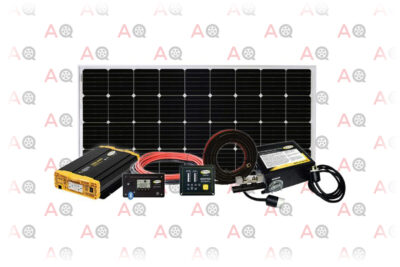
Editor’s Rating:
Facts
- Wattage: 190
- PV Type: Monocrystalline
- Batteries: Not Included
What’s in the Kit?
Included is a high-efficiency panel, wiring, Bluetooth controller, install kit, and pure sine inverter. The pure sine inverter is one of the nicest inverters on our list. With 1500 watts of power, you can run multiple appliances at once, and the “pure sine” part of the description means that you won’t risk hurting any sensitive electronics.
It does not include a battery, but it is set up to be wired into a 30amp service. That’s great if you have a class C that already has a battery bank, but useless if you don’t have batteries already.
Who’s It Best For?
This kit is best for anyone that has a smaller rig and not a lot of roof space. We’re talking about overlanders who only have a few square feet of the truck cab to work with, van campers, and people with teardrop trailers. Everything about the Go Power system is centered around quality and efficiency so you can get the most power from a limited space.
Other solutions for lack of space usually involve collapsible panels, like the XINPUGUANG kit we recommend. Or they are fairly low power like this ACOSYSTEM kit. The Go Power kit is robust, hard mounted, and can still get you enough power to run whatever appliance you need.
Our Thoughts
The Go Power kit is a really high-quality version of the much less expensive WindyNation kit here. That quality shows through in the attention to detail. They actually include a fuse link and a plug for a 30amp service. Other kits don’t include those things.
That price will turn many people away, though, especially since you will still have to source some batteries to take full advantage of it.
Pros
- High-quality
- Includes a pure sine inverter
- Kit includes 30amp hookup
Cons
- Doesn’t include any batteries
- Expensive
5. Most Portable: ACOPOWER 100W Solar Panel Kit
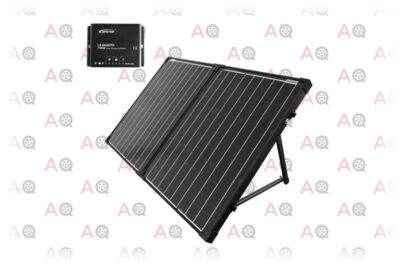
Editor’s Rating:
Facts
- Wattage: 100
- PV Type: Monocrystalline
- Batteries: Not Included
What’s in the Kit?
The entire kit is a weatherproof panel that you have to set up and a simple charge controller. That makes it the kit with the least number of parts on our lists, so if there’s anything else you’d like to have, you’ll have to buy it yourself.
Who’s It Best For?
The biggest advantage of this kit is that you don’t have to mount it to your RV. You just carry it outside, set it up facing the sun, and clip it to your battery. Small trailers, camper vans, and truck campers will benefit from this kit the most since the engine battery is often the only battery on these types of rigs.
It’s also a great kit to buy if you just are not ready to commit to a system you have to install. Since all you have to do is unfold it and throw it down, you don’t have to install anything and risk putting holes in the roof of your RV.
Our Thoughts
We have two big categories of solar kits on our list. Big kits, like the WindyNation 400w or the Go Power 190w, are like residential solar systems. They are installed like residential systems, they work similarly, and you use them the same way you would use 110v power at your house.
The other category is more general purpose. These general-purpose solar kits don’t work like home solar. Kits like this ACOPOWER 100w or the even more portable GVSHINE 30w won’t power your appliances. They work best to keep cell phones or other devices charged, or for running low voltage LED lights. You can use them to charge batteries, but it will take a while since they need to be set up every time you stop. Unlike mounted systems, you can’t charge while driving down the road.
If you don’t need all the comforts of home, you can save a lot of money and get one of these convenient kits. If you take your RV out into the woods to actually enjoy the woods and not enjoy a football game on the TV, then the quiet, easy to transport ACOPOWER 100w is perfect.
Pros
- Portable
- Inexpensive
- Easy to set up
Cons
- Doesn’t include an inverter or batteries
- Not good for running appliances
6. Best Budget: HQST 100 Watt Solar Panel Kit
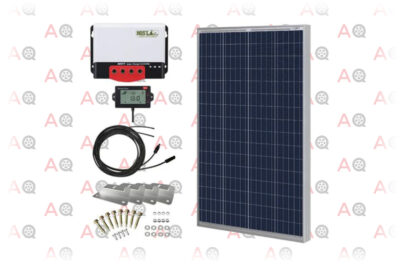
Editor’s Rating:
Facts
- Wattage: 100
- PV Type: Polycrystalline
- Batteries: Not Included
What’s in the Kit?
This kit is neat because you actually get a lot of extras for the price. It comes with the standard panel, wires, and brackets like most kits do. It also comes with a junction box, LCD readout screen, and a charge controller that can handle a large variety of batteries.
The issue is that none of those parts are great quality. They work, but you can tell that the panel is less sturdy than others by the way it flexes as you work with it. The LCD screen is more like an old calculator than an iPhone, and the included wires are too thin to run longer distances.
Who’s It Best For?
If you saw the Renogy kit and thought it looked perfect, but you recoiled at the price, this is the kit for you. Even if you opt to double the power output to 200w by buying an extra panel, it’s still quite a lot cheaper than the Renogy kit.
You will need to source some batteries, but since this kit is great for a budget build, you won’t feel bad taking the extra time to get a really good deal. Most junkyards have AGM batteries from all manner of junked RV and industrial trucks. Bring the yard attendant some donuts and ask them for the good neighbor discount. You can probably get all the batteries you can carry for less than the price of one new lithium.
Our Thoughts
We get it; sometimes, price is the biggest factor when choosing, well, anything. That’s the reason we make these lists. We want people to get the best value for their money that they can, and a big part of that is making sure that even the inexpensive products we recommend will still do what people need them to do.
That’s what the HQST kit is; a product that is inexpensive but will still do what you need it to do. In this case, it will charge batteries and power lights. It won’t do much more than that unless you upgrade the system at a later time. They cost so little, though, that you’ll have money for upgrades when you need them.
Pros
- Inexpensive
- Includes a charge monitor
- Easy to expand
Cons
- Quality could be better
- You’ll want to buy different wiring
7. Best Space Saving: XINPUGUANG 100w Flexible Solar Panel
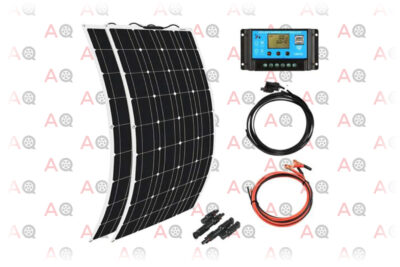
Editor’s Rating:
Facts
- Wattage: 200
- PV Type: Monocrystalline
- Batteries: Not Included
What’s in the Kit?
Two high quality flexible solar panels and a charge controller. Although, if you check the listing, you can actually get this kit with up to 10 flexible panels. 200 watts is enough power to charge 2 batteries without much issue. 1000 watts is enough that you could run a microwave without the batteries.
That’s it, though. You don’t get batteries, inverters, mounting hardware, or anything else. It would be nice if they included some kind of mounting assistance. Even if it’s just suction cups that have hooks on them.
Who’s It Best For?
These panels walk the line between a portable system like the ACOPOWER 100w, and a hard-mounted system like the Renogy. They produce more power than most portable systems but are still considered portable since they don’t mount to the roof. They are flexible and easy to carry around, but they aren’t as simple to set up as a truly portable system.
That makes them the perfect thing for people who will travel out to a destination and stay in one spot for a few days. You drive in, roll out the panels, and you’ll have adequate power during your stay. The big advantage of the flexible panels is that you don’t need any roof space. RVs and trailers like an Airstream that wouldn’t be able to accept a standard panel mount because they have a curved roof are excellent contenders for flexible panels like this.
Our Thoughts
Solar panels come in all shapes and sizes nowadays. These flexible panels are a great example of innovation in the solar industry. They don’t have to be mounted flat, and the biggest advantage is that they don’t take up very much room. They don’t have an aluminum frame or glass top taking up space.
That makes them ideal for anyone that is space limited or who may have to take the panels inside from time to time. Even if you don’t own an RV and are just adding solar to your outhouse for private TV time, you don’t want solar panels out in the elements during strong winds or hail. With these flexible panels, you can just pull them down and stack them out of the way inside.
Pros
- Can charge batteries quickly
- Flexible panels can conform to unusual surfaces
- They are easy to store when not in use
Cons
- Can be hard to set up
- You have to set them up somewhere when you stop
8. Best for High Energy Needs: ECO-WORTHY 1KW Solar Panel Kit
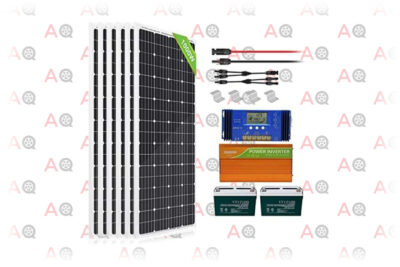
Editor’s Rating:
Facts
- Wattage: 1000
- PV Type: Monocrystalline
- Batteries: 2 100ah AGM
What’s in the Kit?
This is the biggest kit on our list. You get three times the number of panels as the Renogy kit we recommend, and it comes with two batteries. It also has a standard charge controller, plenty of wiring, and a gigantic 3500w pure sine inverter.
Those six panels generate over a kilowatt of power. To put that in perspective, if you run a small AC, your TV, and make toast all at the same time, you’ll still have power left over.
Who’s It Best For?
There are two types of people that would really benefit from a kit this large. Both of them need to own larger RVs. Each panel is a little over two feet wide and a little under five feet long. That means you need 60 square feet of roof space. That’s more than the total square footage of roof space on the average class C RV.
The first type of person who can benefit from a large system like this is the type of person who uses an RV as a more permanent home. If you regularly use appliances during the day, this solar kit will run them without charging batteries. That way, you can park anywhere, even if they don’t have hookups, and enjoy all the amenities you get from running the generator without burning the fuel.
The second type is the RV owner with a big family. It’s hard for one or two people to use more than a few hundred watts in a day when you are at camp. It’s easy for 5 people with cellphones, laptops, Nintendos, and a constant need to open and close the fridge for the fifteenth time to use a ton of power over the course of a day. If you’re running a washer/dryer combo for example, the extra power might be needed.
Our Thoughts
This kit is gigantic, costs a lot, and generates way more power than the average RV crew can use. For most campers, the WindyNation 400w is more than adequate. There’s only so much popcorn you can pop, after all.
If you do need a lot of power, though, then it’s a very nice kit. The pure sine inverter is one of the higher quality inverters you can buy, and the two included batteries will expand your storage capacity. If you plan on being off-grid for a while or just have a lot of friends that you want to take road tripping, there’s no better value than this kit.
Pros
- Generates a lot of power
- Has an excellent inverter
- Includes batteries
Cons
- Takes up a lot of space
- Expensive
9. Best Simple Travel Kit: GVSHINE 30W Panel Foldable Solar Panel Kit
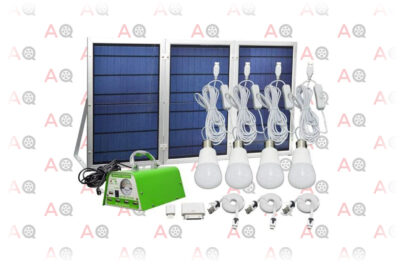
Editor’s Rating:
Facts
- Wattage: 30
- PV Type: Polycrystalline
- Batteries: 1 14ah Lithium
What’s in the Kit?
This is a really fun kit. The battery isn’t a standard AGM or RV battery; it’s a green brick with a handle on it so you can carry it around. The solar panel is the size of a laptop when it’s folded up, and the kit includes lights that automatically turn on with motion.
It’s not a kit that will charge batteries or run appliances. The 30w panel only generates ⅓ the power of the portable ACOPOWER panel, and that’s not enough power to even try to run a microwave. It will charge a phone, power a tablet, and run a handful of lights, though.
Who’s It Best For?
The perfect place for this kit is in the trunk of the car towing an older camper trailer. Or anyone with smaller trailers, or people who bring tents with them when they go out RVing. Anywhere that you won’t have access to batteries or don’t have an electrical system installed already.
One of the neat things about this kit is that it’s incredibly portable, so while it is great for lighting up an RV or campsite, it’s also great to just have around your house in case the power goes out. It’s also great for keeping in your truck for emergency cell phone power.
Our Thoughts
The GVSHINE solar kit’s greatest strength is also its greatest weakness. It’s tiny and easy to set up. That makes it perfect for lights, but it can’t charge a big battery or run a water pump.
Not everyone needs to run appliances, though. For a large number of outdoorsy types, even the lights and cell phone charging are a luxury that they usually wouldn’t have. This unit is fantastic for that.
Pros
- Very portable
- Battery and panels don’t take up much space
- Has lights and USB chargers included
Cons
- The battery can’t run appliances
- The panel won’t charge larger RV batteries
10. Best Kit With a Backup Source: ECO-WORTHY Wind and Solar Power Kit

Editor’s Rating:
Facts
- Wattage: 100 (solar) 400 (wind)
- PV Type: Monocrystalline
- Batteries: Not Included
What’s in the Kit?
Most of this kit is fairly standard. You get a panel, a charge controller, some cables, and some brackets. When it comes to solar, this kit is pretty much exactly the same as the budget HQST kit.
What really sets it apart – and the reason to buy this kit instead of any others – is the wind turbine. The 400w wind turbine is a great way to generate green energy without relying on the sun.
Who’s It Best For?
The easy answer is that it’s for anyone that uses their RV as a base. If you are scientists out doing research or living on a remote constructing site, then you want as many options as you can get to make sure your power never runs out. Especially if you go to a place that doesn’t get very much sunlight, like Seattle or Alaska in winter.
In our view, the person who is going to gravitate towards this kit the most are those with a strong interest in green energy. It’s great for anyone who wants to experiment with wind power and off-grid living.
Our Thoughts
Sometimes when we write these lists, we like to include products that people might not know to exist. These products are usually not a good answer for everyone but might inspire a few people who like cutting edge gadgets or out of the box thinking. We included this kit for those people.
Solar is a fantastic option for getting green power. Even though it’s low efficiency in the grand scheme of things, it is the simplest and most accessible energy production available to the average person. But it has a lot of drawbacks. It takes up a lot of surface area, it doesn’t work unless it’s in direct sunlight, and it’s susceptible to damage from the weather. A wind turbine only needs moving air to generate power, and they are easy to stow if the weather takes a bad turn.
Unfortunately, this kit really is more of an entry-level product. Something for you to experiment with and engineer solutions for. It’s not really meant for an RV that’s going to be moving around all the time, and they don’t include mounting hardware that is conducive to RV use. These problems are compounded by the fact that you need a higher level of research and skill to connect everything. Wind power is more complicated to work with than the fairly constant, easy to work with solar power.
Pros
- Can generate power even when you have no sunlight
- Inexpensive
- Is a great kit for experimenting with
Cons
- Not specifically for RVs
- You need to DIY a lot of components
The Big Guide to RV Solar
Welcome to our big guide. Here we will go over the benefits of solar, the finer details of the design, and answer some of the frequently asked questions surrounding RV solar.
The Pros and Cons of RV Solar
We’ll start this section by answering one of the biggest questions: why would you install solar on your RV?
The short answer is that generators are noisy and pollute, and PV arrays do not. In order to get a detailed answer, let’s compare the good and the bad parts of solar electricity.
Pros
- Solar is quiet. Kits like the WindyNation 400w system can replace a loud generator. Most kits like the Renogy 200w will greatly diminish the number of times you’ll have to start the generator.
- It’s an accessible way to harness green energy. Residential solar kits can easily climb into the tens of thousands of dollars. Putting solar on your RV can be as little as a few hundred bucks, and you can even experiment with wind power.
- It increases the resale value of your RV.
- It’s an easy way to add an electrical system to a trailer or camper that does not currently have one.
Cons
- If you only camp at places with electric hookups, there’s no benefit.
- It has a high initial investment cost.
- Solar panels don’t work well in the rain. You may still need a gas generator as a backup.
The Parts of an RV Solar Setup
We mentioned them briefly above, but solar electric systems are made of a few core components. Here we’ll get a little more in-depth on each part and talk about what parts you may already have on your RV.
Panels
Panels are the most prominent feature of a solar panel system. The average panel is about 2ft x 5ft in size, and, unless they are flexible panels like the XINPUGUANG kit, they will have an aluminum frame that’s about 2in thick.
There are three main types. You can read about the three types here if you want the science. The two types you will come across most are monocrystalline panels and polycrystalline panels.
Monocrystalline panels are more efficient but cost more. Polycrystalline panels cost less but are less efficient. You can see it in action if you compare the Go Power Weekender with the WindyNation 100 watt. They both use a panel that is about the same size. The WindyNation panel is both significantly cheaper and produces 90 watts less than the Go Power panel does.
Wires
The wires included in kits vary a lot, and sometimes you’ll need longer wires or bigger cables for different applications. The wire is measured in gauge, then classified by material and construction. The higher the gauge, the smaller the wire. Most wires are either copper or aluminum and either solid or stranded.
There are two main things you need to know to calculate wire size: length and amperage. The best thing to do is use an online calculator like this one to make sure you are getting the right diameter and material.
Charge Controller
A charge controller is a relatively simple device. Batteries can’t handle max amperage all the time; they have to be charged in a controlled way to keep them from dying prematurely. The only significant consideration for choosing a charge controller is the type and size of battery they can charge. Most modern controllers, like the one included with the Renogy system, can handle most battery types and sizes, so it’s usually not a concern when choosing a kit.
Batteries
You’ll come across two main types of batteries in the RV world: AGM and Lithium. You can read about them here, but the basic rule is that the more charge they can hold, the more they cost. A lithium battery and an AGM battery are the same size, but the lithium battery can hold a lot more charge.
Many kits, like the Go Power kit, do not come with batteries. That’s because most RVs already have a battery bank. You may have to do some research into your RV’s electrical system to know if you want to add more batteries or upgrade them.
Inverter
Inverters turn DC voltage, the voltage from solar panels and batteries, into AC voltage, which is used to power appliances. Inverters are measured in watts and come in two main styles. Pure sine wave inverters are high-quality and are the best at emulating house voltage. Go Power and ECO-WORTHY both include these higher quality pure sine wave inverters.
Modified sine wave inverters are of lower quality and don’t produce “clean” energy. You can get into the science here. Appliances will run worse on a modified inverter, especially things like heaters and microwaves that use constant power. Some devices, like sensitive laptops or modern HD TVs, risk being damaged by modified sine waves.
Unless you are really on a strict budget, get a pure sine wave inverter. The WindyNation 400w kit comes with a modified wave inverter, and we honestly suggest you get rid of it and buy a different one.
Your RV may already have an inverter. If you can use your 110v outlets when your generator is off and you aren’t hooked up to a service, you already have an inverter. Hurray for small mercies.
Usable Power
We apologize; we realize this is a lot of information. Unfortunately, that’s the nature of solar energy. The good news is that all this information translates directly to setting up solar on your house, so if you ever plan to do that, you are already equipped with a lot of the knowledge.
DC Power
You don’t actually need an inverter to take advantage of solar panels or batteries. You can do a lot of neat things with just DC power. This GVSHINE kit here is a great example of how you can use a solar panel without needing 110 volts.
Lights, batteries of all types, pumps, starters, and specialty equipment like DC TVs and stereos can run off a simple panel and single battery setup. If the panel is big enough, you don’t even need the battery.
There are two primary voltages for RV electrical systems: 12v and 24v. You will have to do some research to find out what your RV is wired for since most kits and battery systems can be set up for either style.
AC Power
For the average person, AC power is more straightforward than DC power. It’s the power that comes out of the wall in your home. It will be 110-120v, and it’s what powers all your modern appliances. To turn the DC power from batteries or panels into AC power, you need an inverter. We discussed those more in-depth above.
Watts
Wattage is easy to calculate. You take the voltage and multiply it by the amperage. A small microwave that plugs into a standard wall outlet needs 110 volts and draws 5 amps. 110×5=550 watts.
You’ll notice that most kits, even the larger WindyNation 400w, don’t produce enough power to run that small microwave. That’s why we spent so much time in this guide talking about inverters and batteries. Having a battery bank with an inverter is the only way to power most household appliances without needing to buy a ton of solar panels, like with this kit.
FAQ
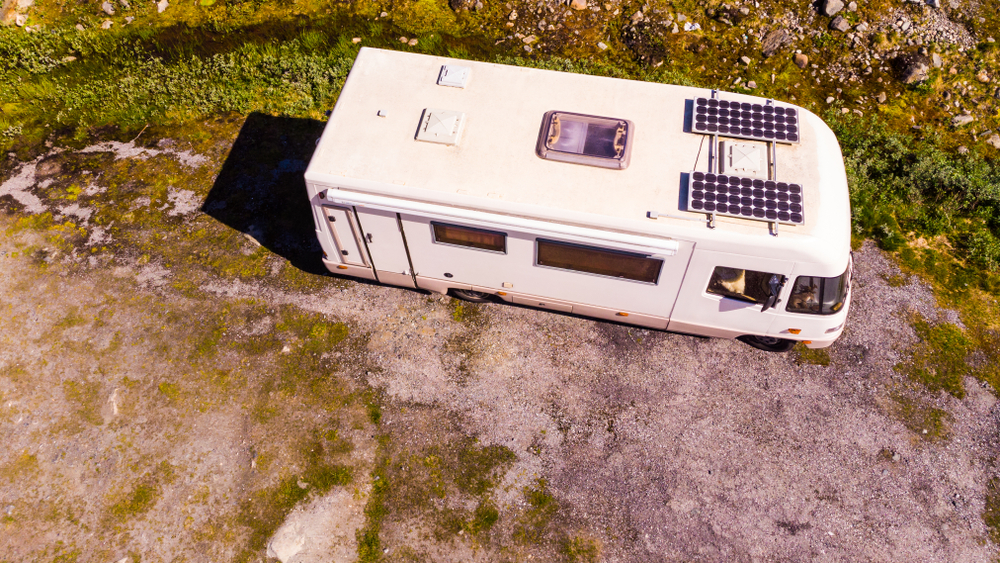
How Many Watts of Solar Do I Need?
If you don’t want to use a simple online calculator like this one, head over to this webpage to learn how to do the math.
How Many Batteries Can a 100w Solar Panel Charge?
A 100-watt solar panel can output 30 amp-hours a day. An average AGM battery is rated at 100 amp hours, but you should never regularly discharge a deep cycle battery below 50%, so a single 100-watt panel will charge 2/3s of a standard AGM battery.
That’s why many kits, like the Renogy kit we recommend, come with 2 solar panels as standard, producing a total of 200w; it will charge a standard battery in one day easily.
Can You Run Your AC With Solar Panels?
The answer is yes, but only if you have the solar panels charging batteries that are hooked up to an inverter. It is very unlikely that you can run an AC on solar power alone unless you have a very large array.
Are Solar Panels for an RV Worth It?
We go over that in this section, but to make a long story short: yes, they are. Solar panels are good for your wallet in the long run, they are good for the Earth, and they can generate quiet power in remote places.
Enjoy Peaceful Power
Whether you are a hardcore RV enthusiast that regularly takes trips across the US or just a weekend pavement warrior who’s on a first-name basis with your local KOA, RV solar can make your outing more enjoyable. You won’t have to rely on hooking up to the power, and you won’t be “that guy” who starts up their generators at 6am because you need to make coffee.

